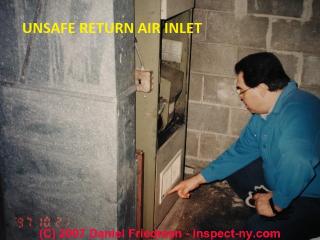 Dangerous HVAC Ductwork
Dangerous HVAC Ductwork
Unsafe Air Conditioning or Heating Duct Openings
- POST a QUESTION or COMMENT about HVAC air duct safety hazards
Unsafe air ducts:
This HVAC diagnosis & safety hazard article describes unsafe air conditioning or heating duct openings such as openings that may cause fatal production of carbon monoxide and move it into the occupied building space. Openings in the wrong place in a heating or air conditioning duct system can transport dangerous gases or other contaminants throughout a building.
Common mistakes in cutting openings in ductwork such as attempts to improve air delivery by placing a return opening at the air handler.
We also discuss air or return duct openings that may pick up and distribute other gases, chemicals, mold or allergens throughout a building.
InspectAPedia tolerates no conflicts of interest. We have no relationship with advertisers, products, or services discussed at this website.
- Daniel Friedman, Publisher/Editor/Author - See WHO ARE WE?
Air Conditioning (or Heating) Duct System Condition & Health/Safety Hazards
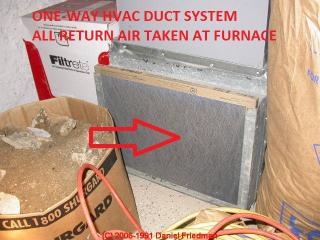 Unsafe Air Inlet Openings at Air Conditioning or Heating Duct System May Draw Dangerous Combustion Gases
Unsafe Air Inlet Openings at Air Conditioning or Heating Duct System May Draw Dangerous Combustion Gases
Return air collected close to gas-fired appliance
This poorly-designed central air conditioning return duct was located in a cramped basement boiler room only five feet from a large gas-fired, natural draft heating boiler.
It is a possible safety concern. When the location of the system return air duct work and air handler is such that the system may pull dangerous flue gases back out of the gas appliance flue vents, piping and into the building heating or cooling air we cite it as a potential hazard: distribution of combustion gases may be blown into the living area.
This return air location on a heating or air conditioning system is a dangerous carbon monoxide hazard.
Such a system should be examined promptly and corrected by a qualified heating professional.
Also see LEAKY DUCT CONNECTIONS for other examples of duct leaks and openings. The master document, of which this is a chapter, describes the inspection of residential air conditioning systems (A/C systems) to inform home buyers, owners, and home inspectors of common cooling system defects.
Page top photo: that image shows a return air inlet in the bottom of the furnace return air plenum.
Watch out: a return air inlet close to a gas heating furnace may be unsafe, drawing combustion products or fatal carbon monoxide into the building air supply, shown in our photo above.
In addition to reading this article also see BACKDRAFTING HEATING EQUIPMENT and
also COMBUSTION AIR for TIGHT BUILDINGS for additional explanation of backdrafting causes, dangers, and cures.
Unsafe Return Air Openings Near Heating Equipment
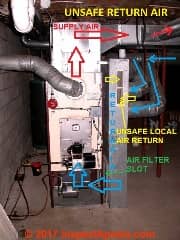
Still more common is the presence of extra openings cut into the return ducts atop a building furnace (perhaps also serving as the air conditioning blower system in cooling season).
In our page top photo our client is pointing to an unsafe return air inlet cut into the bottom of the furnace. Here is another example of the same problem.
[Click to enlarge any image] to see more detail.
Watch out: In our photo shown here we marked in yellow an unsafe return air inlet grille placed right in the basement on the reutrn air plenum itself.
Drawing return air from close to the oil or gas burner on a furnace can
- cause improper burner operation (interfering with combustion air supply)
- draw oil fumes or gas odors into the building supply air
- can kill building occupants if these conditions cause carbon monoxide production and spillage at a gas burner
Often these openings are added to provide more return air to a system which is not providing sufficient cooling or heating to the building.
But making return air openings right at a heating appliance, such as shown in the photo here, risks drawing combustion gases into the building air supply as well as potentially interfering with proper appliance draft and combustion.
This is the case particularly with gas fired furnaces, boilers, or water heaters, which operate at a lower and usually natural draft, but it is also a potential safety hazard with oil-fired equipment.
Flue gases from nearby heating or water heater appliances are easily drawn into the return air plenum and air handler. This would permit circulation of flue gases into the living area and can be a safety hazard which could deliver potentially fatal carbon monoxide to building occupants.
"Hidden" Duct or Air Handler Leaks
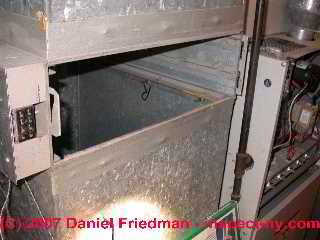
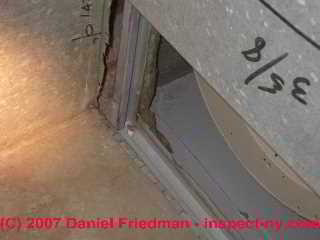
Here is an interesting case of a surprise air leak into the return air plenum at a gas-fired hot air furnace and air conditioning system.
We removed the (not working) electrostatic air cleaner (first photo) to look into the return plenum where we saw a large gap between the return plenum and the blower compartment (second photo).
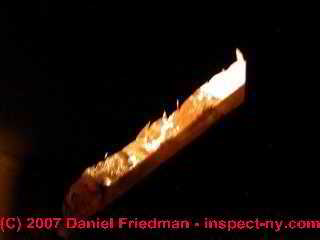 When the gas burner was operating along with
the blower (in heating mode) this opening could certainly draw un-wanted gases into the duct system and might lead to CO production too.
When the gas burner was operating along with
the blower (in heating mode) this opening could certainly draw un-wanted gases into the duct system and might lead to CO production too.
In cooling or air conditioning mode, the blower was pulling in air from the basement (where we had a mold concern).
The third photo (shown here) of this surprise but quite large leak into the air duct system at the air handler was made by
placing our flashlight behind the blower assembly to make it easy to see the size of the opening.
Carbon Monoxide Production Caused by Improperly Located Return Air Ducts/Registers
Return air openings close to natural-draft fired appliances, again particularly gas, can also interfere with proper gas (and possibly oil) burner operation by competing for combustion air, thus causing carbon monoxide production when the burner is operating.
If openings are found in the duct system near fossil-fuel fired appliances it should be reported as an indication of a system operating problem (inadequate return air) and as a safety hazard (potentially fatal carbon monoxide poisoning).
Review this potential hazard with a qualified service professional. For example, should a stack pipe fail and flue gas be dumped into the furnace room it would be picked up and distributed throughout the building.
Sample Air Conditioning Or Heating System Report Language for Unsafe Duct Openings
Sample inspection report language for dangerous HVAC ductwork openings:
*** Safety Hazard - additional details: when the heating system [or air conditioning system] is running and/or when other nearby heating equipment is running (such as a water heater) there is negative pressure around the furnace [or air handler unit] and at this return air inlet register, (demonstrated during our inspection by seeing the furnace blower pull the utility room door shut) risking pulling dangerous flue gases such as carbon monoxide out of the flue vent pipe and into the building heating air through the barometric damper or through other openings in the vent piping.
This item should be handled as soon as possible by an experienced and qualified heating professional - carbon monoxide poisoning is a potentially fatal safety concern.
...
Continue reading at DUCT DAMAGE, MECHANICAL or select a topic from the closely-related articles below, or see the complete ARTICLE INDEX.
Or see these
Recommended Articles
- ASBESTOS HVAC DUCTS & FLUES field identification photos and guide
- FIBERGLASS HAZARDS - home
- RETURN AIR REGISTERS & DUCTS
Suggested citation for this web page
UNSAFE DUCT OPENINGS at InspectApedia.com - online encyclopedia of building & environmental inspection, testing, diagnosis, repair, & problem prevention advice.
Or see this
INDEX to RELATED ARTICLES: ARTICLE INDEX to HVAC DUCT SYSTEMS
Or use the SEARCH BOX found below to Ask a Question or Search InspectApedia
Ask a Question or Search InspectApedia
Try the search box just below, or if you prefer, post a question or comment in the Comments box below and we will respond promptly.
Search the InspectApedia website
Note: appearance of your Comment below may be delayed: if your comment contains an image, photograph, web link, or text that looks to the software as if it might be a web link, your posting will appear after it has been approved by a moderator. Apologies for the delay.
Only one image can be added per comment but you can post as many comments, and therefore images, as you like.
You will not receive a notification when a response to your question has been posted.
Please bookmark this page to make it easy for you to check back for our response.
IF above you see "Comment Form is loading comments..." then COMMENT BOX - countable.ca / bawkbox.com IS NOT WORKING.
In any case you are welcome to send an email directly to us at InspectApedia.com at editor@inspectApedia.com
We'll reply to you directly. Please help us help you by noting, in your email, the URL of the InspectApedia page where you wanted to comment.
Citations & References
In addition to any citations in the article above, a full list is available on request.
- Owens Corning Duct Solutions - www.owenscorning.com/ductsolutions/ - provides current HVAC ductwork and duct insulating product descriptions and a dealer locator. Owens Corning Insulating Systems, LLC, One Owens Corning Parkway, Toledo, OH 43659 1-800-GET-PINK™
- "Flexible Duct Media Fiberglas™ Insulation, Product Data Sheet", Owens Corning - see owenscorning.com/quietzone/pdfs/QZFlexible_DataSheet.pdf
"Owens Corning Flexible Duct Media Insulation is a lightweight, flexible, resilient thermal and acoustical insulation made of inorganic glass fibers bonded with a thermosetting resin." - Our recommended books about building & mechanical systems design, inspection, problem diagnosis, and repair, and about indoor environment and IAQ testing, diagnosis, and cleanup are at the InspectAPedia Bookstore. Also see our Book Reviews - InspectAPedia.
- Complete List of Air Conditioning & Heat Pump Design, Inspection, Repair Books at the InspectAPedia Bookstore.
- In addition to citations & references found in this article, see the research citations given at the end of the related articles found at our suggested
CONTINUE READING or RECOMMENDED ARTICLES.
- Carson, Dunlop & Associates Ltd., 120 Carlton Street Suite 407, Toronto ON M5A 4K2. Tel: (416) 964-9415 1-800-268-7070 Email: info@carsondunlop.com. Alan Carson is a past president of ASHI, the American Society of Home Inspectors.
Thanks to Alan Carson and Bob Dunlop, for permission for InspectAPedia to use text excerpts from The HOME REFERENCE BOOK - the Encyclopedia of Homes and to use illustrations from The ILLUSTRATED HOME .
Carson Dunlop Associates provides extensive home inspection education and report writing material. In gratitude we provide links to tsome Carson Dunlop Associates products and services.

